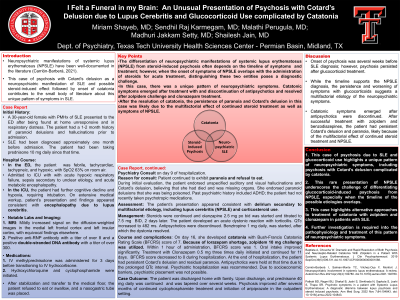Neurocognitive Disorders and Neuropsychiatry
(083) I Felt a Funeral in my Brain: An Unusual Presentation of Psychosis with Cotard’s Delusion due to Lupus Cerebritis and Glucocorticoid Use complicated by Catatonia


Miriam Shayeb, MD (she/her/hers)
Resident Physician
Texas Tech University Health Sciences Center - Permian Basin
Midland, Texas- SK
Sendhil Raj Karmegam, MD
Resident Physician
Texas Tech University of Health Sciences Center- Permian Basin
Midland, Texas - MP
Malathi Perugula, MD
Resident
Texas Tech University Health Sciences Center
Midland, Texas - MJ
Madhuri Jakkam Setty, MD
Assistant Professor of Psychiatry
Texas Tech University Health Sciences Center-Permian Basin
Odessa, Texas - SJ
Shailesh Jain, MD
Professor
Texas tech HSC at permian basin
midland, Texas
Presenting Author(s)
Co-Author(s)
Background:
Neuropsychiatric manifestations of systemic lupus erythematosus (NPSLE) have been well-documented in the literature (Carrión-Barberà, 2021). In this case, a patient with SLE had both auditory and visual hallucinations and Cotard’s delusion followed by onset of catatonia during hospitalization. This case contributes to the small body of literature about this unique pattern of symptoms observed in patients with NPSLE.
Case:
A 30-year-old female with a recent diagnosis of SLE presented with a 2-month history of paranoid delusions and hallucinations. She was admitted to intensive care with acute hypoxic respiratory failure. The patient had a positive anti-RNP antibody and positive dsDNA antibody. Further work-up revealed findings consistent with encephalopathy because of lupus cerebritis. The patient was paranoid, refusing to eat, with severe anxiety. Upon evaluation, she endorsed Cotard’s delusion, paranoia about being poisoned, and auditory and visual hallucinations. In response to the ongoing requirement for steroids, a brief trial of oral olanzapine was started but subsequently ceased because of the occurrence of an acute dystonic reaction. The patient then developed catatonia. Due to lorazepam shortage, zolpidem challenge was used. The patient responded dramatically to the zolpidem challenge and multiple days of clonazepam treatment. After resolving catatonia and medical stabilization, the patient had persistent Cotard’s delusion and paranoia.
Discussion:
This case report highlights an unusual presentation of neuropsychiatric symptoms in SLE with Cotard’s delusion and catatonia. The challenge of differentiating psychosis because of NPSLE from glucocorticoid-induced psychosis is underscored (Pathak, 2022). The patient had onset of psychosis several weeks prior to SLE diagnosis; however, psychosis persisted after treatment with glucocorticoids.
While the timeline supports diagnosis of NPSLE, the persistence and worsening of symptoms with glucocorticoids suggests a multifactorial etiology of the patient’s neuropsychiatric symptoms. Catatonic symptoms emerged after antipsychotics were discontinued. After successful treatment with zolpidem and benzodiazepines, the patient had persistent Cotard’s delusion and paranoia, likely because of the multifactorial effect of continued steroid treatment and NPSLE.
Conclusions:
This case highlights a unique pattern of psychotic symptoms in NPSLE and the challenge of differentiating NPSLE from glucocorticoid-induced psychosis. It highlights alternative approaches to treatment of catatonia. Further investigation is required to fully characterize the pathophysiology and treatment of this pattern of neuropsychiatric symptoms.
References:
Carrión-Barberà I, Salman-Monte TC, Vílchez-Oya F, Monfort J. Neuropsychiatric involvement in systemic lupus erythematosus: A review. Autoimmun Rev. 2021 Apr;20(4):102780. doi: 10.1016/j.autrev.2021.102780.
Pathak BD, Regmi BU, Dhakal B, Joshi S, Simkhada N, Sapkota S, Joshi S, Thapa SR. Psychotic symptoms in a patient with Systemic Lupus Erythematosus: A diagnostic dilemma between lupus psychosis and steroid induced psychosis. Ann Med Surg. 2022 Nov 7;84:104843. doi: 10.1016/j.amsu.2022.104843.
Presentation Eligibility: Not previously published or presented.
Diversity, Equity, and Inclusion: Autoimmune conditions are most prevalent in women and disproportionately affect minority populations (Izmirly, 2021). Socioeconomic barriers impacted this case of SLE presenting with neuropsychiatric symptoms. Further research is required regarding the role of social determinants of health in SLE.
Reference: Izmirly PM, Parton H, Wang L, et al. Prevalence of Systemic Lupus Erythematosus in the United States: Estimates From a Meta-Analysis of the Centers for Disease Control and Prevention National Lupus Registries. Arthritis and Rheumatology 2021;73(6):991-96. doi: 10.1002/ART.41632.

